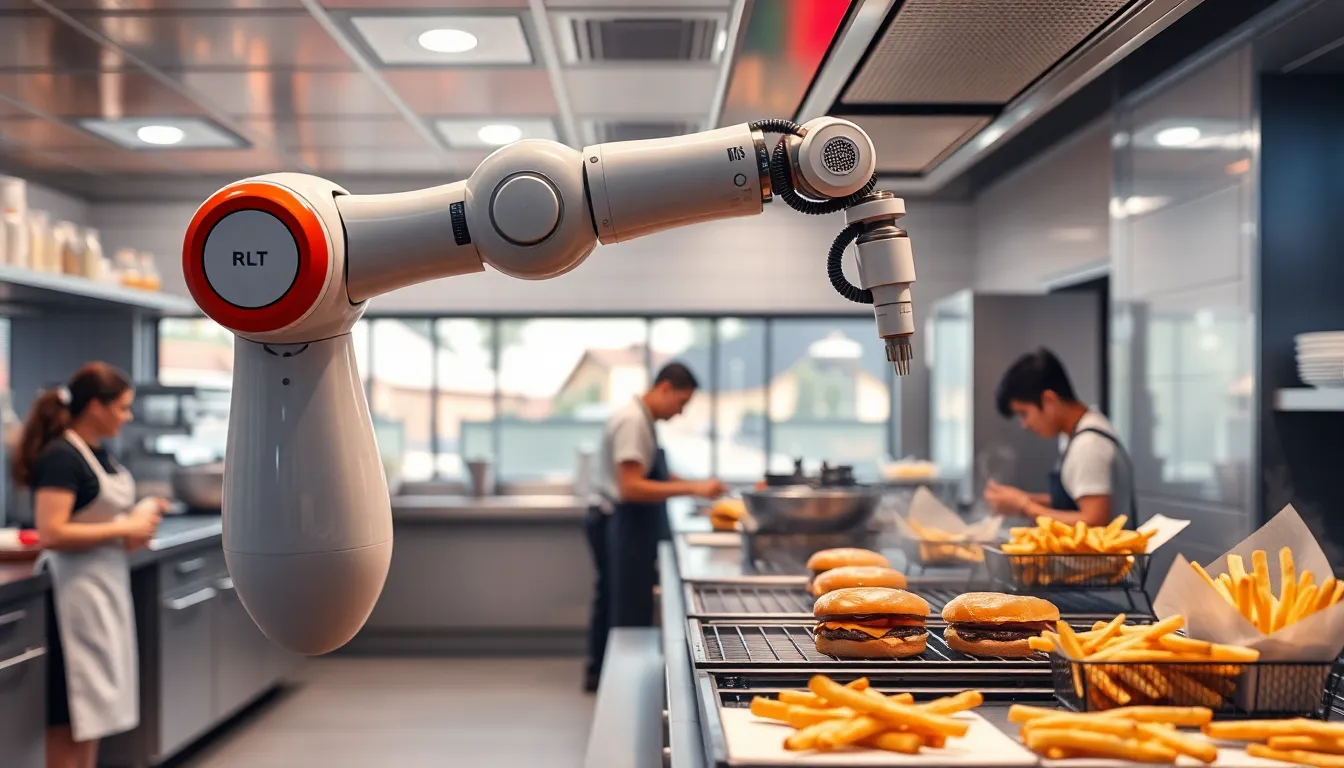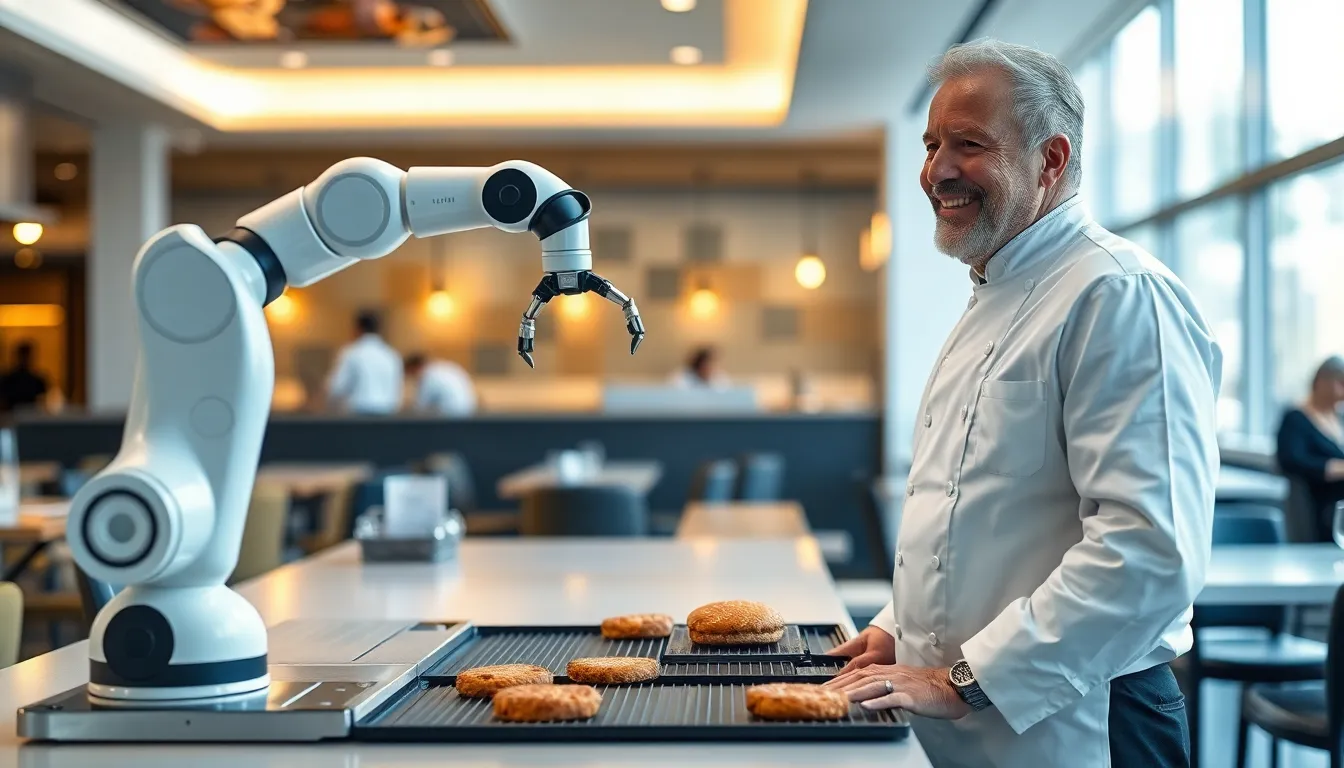In a world where robots are no longer confined to sci-fi movies, Miso Robotics is leading the charge in culinary innovation. Imagine a kitchen where a robot chef whips up gourmet meals while you kick back and enjoy a well-deserved break. It sounds like a dream, but Miso Robotics is turning that dream into reality, one delicious dish at a time.
Table of Contents
ToggleOverview of Miso Robotics
Miso Robotics leads in integrating robotics with culinary processes. The company’s products include Flippy, a robotic kitchen assistant dedicated to grilling and frying, and Drinkworks, a cocktail automation system. These innovations enhance efficiency in food preparation, reducing wait times for customers.
Flippy represents a significant advancement in kitchen technology. It utilizes artificial intelligence to manage cooking tasks, ensuring consistency and quality in the food served. The robot can flip burgers, fry chicken, and even assemble sandwiches, all while adapting to real-time kitchen dynamics.
Miso Robotics also emphasizes data analytics in its operations. The platform tracks various metrics, such as food waste and ingredient usage, allowing kitchens to optimize their resources. This data-driven approach helps restaurants improve profit margins while maintaining high standards of service.
Innovations from Miso Robotics do not stop at cooking tasks. The company actively explores automation in food delivery and inventory management, contributing to a streamlined workflow in restaurants. Such advancements minimize labor costs and mitigate challenges associated with staffing shortages.
Collaboration is key for Miso Robotics. Partnerships with major restaurant chains facilitate the deployment of their technology in real-world settings. Success stories from establishments that adopted these robotic solutions demonstrate enhanced operational efficiency and customer satisfaction.
Miso Robotics reshapes the culinary landscape through its pioneering efforts. Investments in research and development ensure continuous improvements, keeping the company at the forefront of the food tech industry. As the kitchen of the future becomes increasingly automated, Miso Robotics remains a significant player in this transformation.
Key Technologies

Miso Robotics employs advanced technologies to revolutionize the culinary industry. These innovations include artificial intelligence, machine learning, robotics, and automation.
AI and Machine Learning
Artificial intelligence plays a crucial role in Miso Robotics’ operations. It enhances Flippy’s ability to learn from cooking patterns and adapt to various recipes. Machine learning algorithms analyze customer preferences, ensuring personalized dining experiences. Data collected from kitchen activities reveals insights that optimize cooking processes. With continuous learning, these systems refine their performance, maintaining quality and consistency in food preparation. Chefs benefit from reduced guesswork and increased accuracy in their culinary tasks.
Robotics and Automation
Robotics lies at the core of Miso Robotics’ offerings. Robotic arms like Flippy handle tasks such as grilling and frying with precision. Automation streamlines kitchen workflows, allowing staff to focus on creativity and customer service. Efficient inventory management systems track ingredient usage in real-time, minimizing waste and costs. Automated systems also ensure quick response times, enhancing customer satisfaction. Through its innovative approach, Miso Robotics addresses staffing challenges and improves overall operational efficiency.
Applications of Miso Robotics
Miso Robotics integrates advanced robotics into various sectors, enhancing efficiency and redefining standards.
Food Industry
In the food industry, Miso Robotics revolutionizes cooking processes with its flagship product, Flippy. This robotic kitchen assistant handles grilling and frying tasks, ensuring food quality and consistency. By using artificial intelligence, Flippy learns cooking patterns and adapts to recipes. Its deployment results in reduced wait times and streamlined operations. Additional innovations, like automated fryers and grills, support chefs, allowing them to focus on creativity rather than routine tasks. Data analytics tracks food waste and ingredient usage, enhancing profit margins while optimizing resource management.
Hospitality Sector
In the hospitality sector, Miso Robotics contributes to improved service efficiency and customer satisfaction. Automated systems, such as Drinkworks, provide consistent cocktail preparations, increasing speed during busy hours. Staff members benefit from these advancements, freeing them to prioritize customer interactions and elevate guest experiences. Real-time inventory management systems minimize waste and ensure timely replenishment of supplies. Collaborative efforts with major restaurants demonstrate successful technology implementation, leading to increased operational efficiency and enhanced dining experiences for guests. Through these applications, Miso Robotics transforms the hospitality landscape, driving innovation in service delivery.
Benefits of Miso Robotics
Miso Robotics offers various benefits, particularly in efficiency and safety, as its innovations redefine culinary operations.
Efficiency and Cost Savings
Miso Robotics enhances operational efficiency with automation. Robots like Flippy optimize food preparation processes, reducing cooking times significantly. Restaurants experience lower labor costs since fewer staff members are needed to manage kitchen tasks. Data analytics provided by the technology minimizes food waste through precise ingredient tracking. Profit margins improve as a result of these efficiencies, allowing business owners to allocate resources more effectively. Faster service also boosts customer satisfaction, encouraging repeat visits. Adopting these automated solutions leads to streamlined workflows, saving valuable time.
Improved Safety Standards
Miso Robotics elevates safety standards in the kitchen environment. Robots take on dangerous tasks, such as handling hot grills and frying equipment, reducing the risk of accidents. Miso’s systems operate with consistent precision, eliminating human error. Enhanced safety protocols occur due to reduced physical strain on staff, which lowers workplace injuries. Monitoring systems track kitchen operations, ensuring compliance with health regulations. By minimizing human interaction with hazardous equipment, Miso Robotics creates a safer atmosphere for employees. Businesses can promote a culture of safety and well-being through the integration of these advanced technologies.
Challenges and Limitations
Miso Robotics faces several challenges and limitations in implementing its innovative technologies in the culinary sector. Understanding these hurdles is essential for evaluating its impact on the industry.
Technological Barriers
Technological barriers present significant hurdles for Miso Robotics. High initial costs associated with integrating robotics deter some restaurants from adopting this technology. Complexity in programming and ensuring compatibility with existing kitchen equipment remains a concern for many operators. Limited access to reliable internet connections affects real-time data utilization, hindering optimal performance. Continued advancements in AI and machine learning are required to improve the adaptability of robotic systems to diverse culinary environments. Enhancements must focus on user-friendliness to ensure that restaurant staff can operate and maintain these systems without extensive training.
Market Adoption
Market adoption of Miso Robotics’ technologies encounters resistance from traditionalists in the culinary field. Many chefs worry that automation diminishes the personal touch in food preparation, limiting creativity. Smaller establishments often lack the financial resources to invest in advanced robotic solutions, leading to uneven adoption across the industry. Regulations surrounding food safety and labor may complicate integration, as compliance with health standards requires thorough validation. As the market evolves, educating stakeholders on the benefits of automation will play a vital role in overcoming these barriers and fostering broader acceptance.
Miso Robotics stands at the intersection of technology and culinary arts. Its innovations are reshaping how food is prepared and served, enhancing efficiency while maintaining quality. As restaurants increasingly adopt these technologies, they not only streamline operations but also improve customer experiences.
The company’s focus on data analytics and automation addresses critical challenges in the food industry, from waste reduction to staffing shortages. While hurdles remain in terms of cost and acceptance, the potential for Miso Robotics to revolutionize the culinary landscape is undeniable. As the industry evolves, embracing these advancements will be key to staying competitive and meeting the demands of modern diners.




